
|
Sale 72
February 2-5. 2013
| Lot |
Photo |
Description |
Realized |
Lot 4050 |
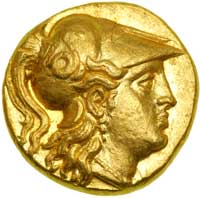 |
Macedonian Kingdom. Alexander III, the Great, 336-323 BC. Gold Stater (8.5g) minted at Amphipolis (?), ca. 280-270 BC. Head of Athena right wearing necklace and crested Corinthian helmet adorned with a coiled serpent. Reverse: Nike (Victory) standing left holding wreath and stylis; M monogram above crescent left in outer left field; reversed Σ I monogram below right wing; MO monogram in wreath below left wing. Price 609. Extremely Fine.
Estimated Value $2,500 - 3,000.
The Hunter Collection.
View details and enlarged photos
| Realized
$4,025 |
Lot 4051 |
 |
Macedonian Kingdom. Alexander III, the Great, 336-323 BC. Silver Tetradrachm (17.24g) minted at Memphis (Egypt) ca. 325-323 BC. Head of Alexander III, the Great right clad in lion's skin headdress. Reverse: Zeus enthroned left, holding eagle in his outstretched right hand and scepter in the left; one foot rests on footrest; rose in left field; below seat, ΔIO. Price 3971 var. Letters below throne double-struck. A lifetime issue struck in Egypt. High relief portrait with soft golden highlights. An oustanding example in fine style from this popular and desirable mint. Extremely Fine.
Estimated Value $4,000 - 5,000.
View details and enlarged photos
| Realized
$8,625 |
Lot 4052 |
 |
Macedonian Kingdom. Philip III, Arrhidaios, 323-317 BC. Gold Stater (8.6 g) minted at Babylon, ca. 323-320 BC. Struck under Perdikkas. Head of Athena right wearing helmet adorned with a coiled serpent. Reverse: Nike (Victory) standing left, holding wreath in outstretched right hand and stylis in left; ΛY below left wing; M below right wing. Price 178. Interesting Athena profile. Sharp and well-centered type. Extremely Fine.
Following the sudden and unexpected death of Alexander the Great at Babylon in 323 BC, the late king's generals decided to place on the throne Alexander's half-brother Philip III, Arrhidaios together with Alexander IV, the infant son of Alexander and Roxane. Feeble-minded, Arrhidaios posed no political threat to the generals who were thus free to divide Alexander's empire between them. The late king's coin types were left unchanged, though on some issues the name of Philip replaced that of Alexander. Arrhidaios was ultimately murdered in 317 BC, the victim of Alexander the Great's mother Olympias, while Alexander IV was executed by Kassander in 309 BC.
Estimated Value $2,500 - 3,000.
The Hunter Collection.
View details and enlarged photos
| Realized
$5,750 |
Lot 4053 |
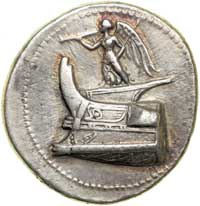 |
Macedonian Kingdom. Demetrios I, Poliorketes, 306-283 BC. Silver Tetradrachm (16.7g) minted at Salamis, ca. 300-295 BC. Nike (Victory) standing left on prow of galley, supporting salpinx with right hand, holding stylis in left. Reverse: ΔHMHTPIOY BA - ΣIΛE - Ω[Σ]. Nude Poseidon advancing left, brandishing trident in right hand, chlamys wrapped around left; to left and right, monograms. Newell 22 (pl. II, 14). Faint signs of old cleaning. Uniform light grey toning with golden highlights. Choice Very Fine.
It was only after the defeat and death of his father Antigonos Monophthalmos at Ipsos (301 BC) that Demetrios Poliorketes began striking coins in his own name, initially with the types of Alexander the Great (Herakles head/seated Zeus). Soon, however, a splendid new type was introduced at Demetrios' Cypriot mint of Salamis, the obverse showing Nike alighting on the forepart of a defeated galley, the reverse a magnificent striding Poseidon. This was in commemoration of Demetrios' celebrated naval victory over Ptolemy of Egypt in the Battle of Salamis resulting in his capture of Cyprus. The type was later struck at other mints under the control of Demetrios.
Estimated Value $3,000 - 4,000.
The Hunter Collection.
View details and enlarged photos
| Realized
$3,335 |
Lot 4054 |
 |
Macedonian Kingdom. Demetrios I, Poliorketes, 306-283 BC. Silver Tetradrachm (17g) minted at Amphipolis, ca 291-290 BC. Diademed and horned head of young Demetrios right. Reverse: BAΣIΛEΩΣ ΔHMHTPIOY. Half-draped Poseidon seated left on rock, holding apluster in outstretched right hand, resting left on trident; to left and right, monograms. Newell 111 (pl. X, 6). Underlying luster present with a touch of natural iridescense. Superb Extremely Fine.
Demetrios I, Poliorketes (the Besieger) was born in 336 BC, the son of Antigonos Monophthalmos (the One-Eyed) who held a high command in the army of Alexander the Great. In the confused period following the unexpected death of the Macedonian conqueror at the age of only thirty-three, Antigonos emerged as one of the most powerful of the Diadochi, and it was he who came closest to reuniting all of Alexander's former Empire. In 301 BC, Antigonos perished in the battle of Ipsos where he was opposed by the combined forces of the other Diadochi. Demetrios survived his father's downfall, and in 294 BC managed to ascend the Macedonian throne, thereby founding a dynasty that was destined to survive until the end of the kingdom. His coin types all follow a maritime theme and are commemorative of his important naval victory over Ptolemy of Egypt at Salamis in 306 BC that resulted in the capture of Cyprus.
This handsome portrait tetradrachm issued at Amphipolis shows a seated figure of Poseidon, brother of Zeus and ruler of the sea. The horn on the royal portrait also refers to Poseidon, as the bull was the sacred animal of the god.
Estimated Value $5,000 - 7,500.
The Hunter Collection.
View details and enlarged photos
| Realized
$6,613 |
Lot 4055 |
 |
Macedonian Kingdom. Demetrios I, Poliorketes, 306-283 BC. Silver Tetradrachm (16.7g) struck after 290 BC. Uncertain mint, perhaps in Asia Minor. Diademed head right of Demetrios, with bull's horn. Reverse: BAΣIΛEΩΣ ΔHMHTPIOY. Naked Poseidon standing left, holding trident in left hand, resting right foot on rock; to left, eight-pointed star above Δ; to right, A. Newell 160 (pl. XVI, 5-7). Well struck and perfectly centered. Traces of underlying luster with delicate golden highlights. An amazing specimen. Superb Extremely Fine.
Estimated Value $7,000 - 10,000.
The Hunter Collection.
View details and enlarged photos
| Realized
$18,975 |
Lot 4056 |
 |
Macedonian Kingdom. Perseus, 179-168 BC. Silver Tetradrachm (15.3g) minted at Pella or Amphipolis, ca. 173-171 BC. Magistrate: AY. Diademed head of Perseus right. Reverse: Eagle, wings spread, standing three-quarters right on thunderbolt; mintmaster's monogram at right; control-mark ΘE monogram above; between eagle's legs, AI monogram; all within oak wreath. Mamroth, Perseus 19b; SNG Berry 382. Minute flan flaw on reverse at 7 o'clock. Lightly toned, perfectly centered, and crisply rendered. Outstanding portrait. Extremely Fine.
Perseus, son of Philip V, was the last king of Macedon prior to the reduction of the country by the Romans. Succeeding his father in 179 BC, he energetically set about trying to restore the prestige of his kingdom, which had been badly shaken by the disastrous defeat of Philip V by the Romans at Cynoscephalae in 197 BC. However, his activities aroused the suspicions of the Roman Senate, resulting in the Third Macedonian War (171-168 BC). The decisive battle was fought at Pydna, where the Roman general Aemilius Paullus inflicted a crushing defeat on the Macedonians, thus ending the long history of the Macedonian monarchy. Perseus was obliged to adorn the triumph of Paullus through the streets of Rome, and he died two years later as an exile in Italy. In the earlier part of his reign, his coinage was struck at the full Attic weight standard (tetradrachm of about 17 grams), but following the outbreak of war in 171 BC, he was obliged to reduce the standard by about ten percent.
Estimated Value $2,000 - 2,500.
The Hunter Collection; Ex Superior Stamp & Coin, June 2, 1992 Sale, Lot 4402.
View details and enlarged photos
| Realized
$2,415 |
Lot 4057 |
 |
Thrace, Abdera. Silver Stater (12.8g) struck ca. 411-385 BC. [A]BΔH. Griffin seated left, wings slightly spread; to left, cicada. Reverse: EΠIΦIΛA / ΔOΣ. Herakles seated three-quarters left, head facing slightly right, on a rock draped with lion-skin, holding club in right hand. May 396 (A277/P322); SNG Lockett 1132 (same obverse die); Gulbenkian 447 (same reverse die). Some flatness on the head of Herakles and surrounding area on the reverse. Lightly toned. Extremely Fine/Choice Very Fine.
Abdera lay on the southern coast of Thrace, to the east of the mouth of the river Nestus. Originally a colony of Klazomenai founded in the seventh century BC, the city did not really begin to flourish until ca. 544 BC when the site was re-occupied by colonists from Teos, refugees from the Persian occupation of their city. Thereafter, Abdera achieved great prosperity, and its coinage commenced within a decade or so of its re-founding. As the coinage of Teos seems to have begun at about the same time, it was agreed that at the mother city, the griffin should face to the right, while at Abdera it should face in the opposite direction. The fabulous creature with a lion's body and the head and wings of an eagle was the civic device of the mother city and was brought with them to their new home. The attractive reverse type of this late fifth-early fourth century issue shows Herakles resting on a rock and is one of a series of Abderite tetradrachms depicting different gods and goddesses.
Estimated Value $4,000 - 6,000.
The Hunter Collection; Ex Superior Stamp & Coin, June 2, 1992, lot 4403.
View details and enlarged photos
| Realized
$3,220 |
Lot 4058 |
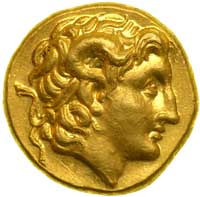 |
Thracian Kingdom, Lysimachos, 323-281 BC. Gold Stater (8.5g). Diademed head of the deified Alexander the Great right, with horn of Ammon. Reverse: Athena Nikephoros enthroned left, holding Nike (Victory) in her extended right hand, resting left elbow on shield with aegis; in left field, caduceus. Müller 109; Thompson--. Struck from somewhat worn dies. Lustrous. Nearly Mint State.
Estimated Value $5,000 - 6,000.
View details and enlarged photos
| Realized
$6,613 |
Lot 4059 |
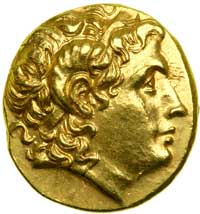 |
Thracian Kingdom. Lysimachos, 323-281 BC. Gold Stater (8.3g) uncertain mint, Pella (?). Diademed head of the deified Alexander the Great right wearing horn of Ammon. Reverse: Athena Nikephoros seated left, two monograms before. Cf. Thompson 241 (similar monograms, letter on throne). Some light marks on the reverse rims and a light scratch in the reverse field near 12 o'clock. Lustrous. Extremely Fine.
Estimated Value $4,000 - 5,000.
The Hunter Collection.
View details and enlarged photos
| Realized
$3,680 |
Lot 4060 |
 |
Thracian Kingdom. Lysimachos, 323-281 BC. Silver Tetradrachm (17.00g) minted at Lampsakos, 297-281 BC. Diademed, deified head of Alexander the Great right wearing horn of Ammon. Reverse: Athena Nikephoros seated left, holding Nike (Victory); herm in outer left field; KA monogram in inner. Thompson 59; Müller 88. Light slate tone with soft russet hues. Marvelous and expressive portrayal of the deified Alexander the Great. Extremely Fine.
Estimated Value $1,500 - 2,000.
Wolfen Family Foundation, purchased from Bank Leu early 1970s.
View details and enlarged photos
| Realized
$3,450 |
Lot 4061 |
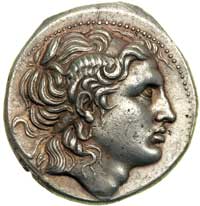 |
Thracian Kingdom. Lysimachos, 305-281 BC. Silver Tetradrachm (17.2g) minted at Amphipolis, 288-281 BC. Diademed head right of deified Alexander the Great, with horn of Ammon. Reverse: BAΣIΛEΩΣ ΛYΣIMAΧOY. Athena Nikephoros seated left, her left elbow resting on grounded shield; on her outstretched right hand, Nike (Victory) standing left to crown king's name; behind, spear; to inner left, outer right, and in exergue, monograms. Thompson 207. Well struck, finely detailed and nicely toned. Extremely Fine.
Estimated Value $1,500 - 2,000.
The Hunter Collection.
View details and enlarged photos
| Realized
$2,243 |
Lot 4062 |
 |
Thessaly, Larissa. Silver Stater (12.24g) struck mid to late Fourth Century BC. Head of the nymph Larissa three-quarter facing left, wearing plain necklace and drop pendant earring, her hair held by an ampyx; border of dots. Reverse: ΛAP above, IΣ downwards to the right; AIΩN below; bridled horse trotting right, tail upright and looped. See L. Hamburger 98 (April 3, 1933) 545 (same dies). A stunning example, sound metal and delicately toned. Extremely Fine.
Estimated Value $7,000 - 8,000.
Ex BCD Thessaly Coll. lot 307; Ex Giessener Munzhandlung 44 (3 April, 1989) 277.
View details and enlarged photos
| Realized
$10,350 |
Lot 4063 |
 |
Thessaly, Larissa. Silver Drachm (6.05g) struck mid to late fourth century BC. Head facing slightly left of the nymph Larissa, wearing ampyx, triple-drop earring, and wire necklace. Reverse: ΛAPIΣ / AIΩN. Horse crouching right, about to roll; below, trident left(?). BCD Thessaly II, 323 (same obverse die); BCD Thessaly I, 1157. Delicate golden highlights. Lustrous. Superb Extremely Fine.
Estimated Value $1,500 - 2,000.
The Hunter Collection.
View details and enlarged photos
| Realized
$3,565 |
Lot 4064 |
|
Withdrawn
| Unsold |
Lot 4065 |
 |
Attica, Athens. Silver Tetradrachm (16.75g) struck ca. 465-415 BC. Head right of Athena in crested Attic helmet adorned with spiral palmette on bowl and three olive leaves above visor, wearing round earring and beaded necklace. Reverse: AΘE. Owl standing right, head facing; to left, olive sprig and crescent moon; all within square incuse. Starr Group II.C, 69 (O62/R64); Seltman 425. Well struck and perfectly centered on sound metal
Very rare and stylistically close to the dekadrachm issues. Absolutely fabulous high relief design. Extremely Fine.
Estimated Value $30,000 - 40,000.
The Hunter Collection; Ex Antiqua II, 1975, Lot 6.
View details and enlarged photos
| Realized
$33,350 |
Lot 4066 |
 |
Attica, Athens. Silver Tetradrachm (17.0g) struck after 449 BC. Head of Athena right, in crested Attic helmet adorned with curvilinear palmette on bowl and three olive leaves over visor, wearing button earring and wire choker over beaded necklace. Reverse: AΘE. Owl standing right, head facing; to upper left, olive sprig and crescent. Cf. Starr pl. XXII, 3. Well struck on a large flan and nicely toned with some earthen deposits still present. Extremely Fine.
Estimated Value $2,000 - 2,500.
The Hunter Collection.
View details and enlarged photos
| Realized
$2,415 |
Lot 4067 |
 |
Attica, Athens. Silver New Style Tetradrachm (16.7g) struck 130 BC. Antiochos, Karaichos, and Protoge: magistrates. Head right of Athena, in triple-crested Attic helmet adorned with palmette on bowl, Pegasos at crown, and four horse protomes above visor, and wearing pendant earring. Reverse: A - ΘE. Owl standing right, head facing, on overturned amphora inscribed I; to right, elephant standing right; in fields, ANT[I] - OΧO / KAPA- / IΧOΣ / ΠPΩ- / TOΓE; below, ΣΩ; around all, laurel wreath. Thompson 398. Lightly toned. Superb Extremely Fine.
The appearance of the name 'Antiochos' combined with an elephant symbol was long regarded by early numismatists as one of the few fixed points in the creation of a satisfactory chronology for the New Style Athenian series. Various attempts were made to establish a common identity between this magistrate and either Antiochos IV (who was living in exile prior to his accession to the Syrian throne in 175 BC) or Antiochos VII (who was in exile in the 140s). However, both Thompson's date for this type (163/162 BC) and Mørkholm's more likely estimate of 131/130 BC preclude a direct connection with the Seleukid monarchy. Since Antiochos was a common enough name in Attic prosopography, this magistrate should be regarded as an Athenian aristocrat, with the elephant symbol merely an allusion to the Seleukid dynasty, so many of whose kings bore this name.
Estimated Value $1,000 - 1,300.
The Hunter Collection.
View details and enlarged photos
| Realized
$2,415 |
Lot 4068 |
 |
Corinthia, Corinth. Silver Stater (8.6g) struck ca. 405-345 BC. Pegasos with curled wing stepping right on exergual line; below belly, koppa and E. Reverse: EY. Head right of Athena in Corinthian helmet; to left, bull's head(?). Cf. Calciati 340 (reverse legend not noted). A remarkable obverse, while the reverse is slightly off-center. Lovely, dark, antique gray toning, slightly iridescent. Extremely Fine/Very Fine.
The ancient city of Corinth lay on the isthmus connecting the Peloponnese with central Greece. The Corinthians were great seafarers and established numerous colonies, some of which themselves rose to greatness, the most notable example being the Sicilian city of Syrakuse. The Corinthian silver stater, weighing about 8.6 grams, was a multiple of a drachm weighing 2.87 grams, and was, thus, a tridrachm. However, it also corresponded in weight to an Attic didrachm, thus adding significantly to its popularity in international commerce. The winged horse, or Pegasos, born from the blood of the gorgon Medusa and tamed by Bellerophon, prince of Corinth, was the constant obverse type for the Corinthian coinage as well as of the city's numerous colonies.
On this beautiful example of a fourth century Corinthian stater, Pegasos appears in an unusual pose, standing instead of flying and with curled instead of pointed wings. The style represents a partial revival of the archaic phase of the Corinthian coinage.
Estimated Value $1,000 - 1,500.
The Hunter Collection; Ex Superior Stamp & Coin, June 2, 1992, lot 4414.
View details and enlarged photos
| Realized
$4,485 |
Lot 4069 |
 |
Sikyonia, Sikyon. Silver Stater (12.18g) 340-330 BC. Chimaira standing left; wreath above; ΣE below. Reverse: Dove flying left; N before; all within wreath. BCD Peloponnesos 218 (same dies); BMC 57; SNG Cop. 48. Delicate gray toning with underlying luster. Exceptional for this issue. Extremely Fine.
Estimated Value $2,500 - 3,000.
View details and enlarged photos
| Unsold |
Lot 4070 |
 |
Elis, Olympia. Silver Stater (12.22g) struck ca. 385-365 BC. F - A. Head right of Hera in stephane, wearing pendant earring and wire necklace; stephane adorned with five palmettes adjoined with tendrils and H - R - A in the spaces. Reverse: Eagle standing left, head reverted, its left wing raised; around, olive wreath; all within circular incuse. Seltman 301c (EU/θξ; this coin) = Babelon pl. CCXXXII, 2 = Jameson I, 1239. Very rare. Attractively toned and of the finest style. Extremely Fine.
The fertile country of Elis in northwestern Peloponnese was the home of Greece's principal sanctuary of Zeus. Situated at Olympia, this was also the site of the famous festival center where, commencing traditionally in 776 BC, the Olympian Games were celebrated every fourth year. The coinage in the name of the Eleans was issued not from the city of Elis itself but from the festival center at Olympia. From the early part of fifth century, an extensive series of coins, principally silver staters, was produced at Olympia honoring both Zeus and his consort Hera. The mints for these coins may even have been situated within the actual temple precincts of the two deities.
This beautiful early fourth century BC stater has the head of Hera on the obverse, her name inscribed on the stephane. The reverse shows an eagle, the bird sacred to Zeus, within an encircling wreath of olive leaves.
Estimated Value $15,000 - 20,000.
The Hunter Collection; Ex Superior Stamp & Coin NYINC Auction, December 8-9, 1995, lot 820; Lanz 70, 21 November 1994, lot 75; Numismatic Fine Arts Auction XXV, November 29, 1990, lot 116; Leu 22, 8-9 May 1979, lot 109; Jameson Collection I, lot 1239; and Hirsch XVI, 1906, lot 573.
View details and enlarged photos
| Realized
$55,200 |
Lot 4071 |
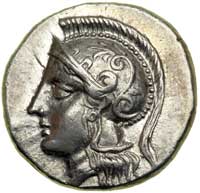 |
Crete, Itanos. Silver Drachm (5.5g) struck ca. 330-270 BC. Head left of Athena, in crested Attic helmet adorned with palmettes. Reverse: ITANIΩN. Eagle standing left, head right, its wings folded; to right, Triton holding trident; all within circular incuse. SNG Lockett 2574 var; Svoronos 41 (pl. XIX, 24). Light reverse scratch behind eagle. Rare. Lustrous surfaces and well struck. Superb Extremely Fine.
Situated in a remote location in the extreme northeast of the island of Crete, the town of Itanos dates from Minoan times, though the archaeological evidence for this period is slight. In the third century BC, an Egyptian garrison was established here, and this led to increasing Ptolemaic influence over the politics of the island. However, the issue represented by this attractive silver drachm appears to precede the Egyptian occupation. The types combine the head of Athena with the eagle of Zeus, while the interesting symbol in the reverse field represents the marine deity Triton, son of Poseidon and his consort Amphitrite.
Estimated Value $4,000 - 6,000.
The Hunter Collection.
View details and enlarged photos
| Realized
$6,038 |
Lot 4072 |
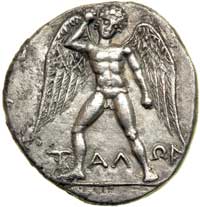 |
Crete, Phaistos. Silver Stater (10.9g) struck ca. 300-270 BC. T - AΛ - ΩN. Naked Talos, wings spread, standing facing on exergual line, poised to throw rock in right hand, holding another rock in his left. Reverse: ΦAIΣTIΩN. Bull butting right on exergual line, head facing. Le Rider 62 (pl. XXIV, 4); Svoronos Numismatique 67 (pl. XXIV, 24); BMC 20. Light to medium antique silver-gray toning. An amazing example with an obverse of exquisite artistry. Extremely rare. Extremely Fine.
The ancient Cretan city of Phaistos was situated close to the island's southern coastline, west of its more powerful neighbor Gortyna. A settlement of great antiquity, Phaistos is best known for its Minoan palace and underlying pre-palatial village. The extensive coinage of the place commenced in the mid-fifth century BC and seems to have extended down to the early decades of the third century. The obverse of this late stater has a striking winged nude male figure advancing to front. The inscription names him as Talos, an enigmatic deity whose story is complex and shrouded in mystery. Likely a local, pre-Classical solar deity, Talos was said to be a winged giant made of bronze whose mission was to protect Zeus' beloved Europa while she was in Crete. To do this, Talos would circle the island three times daily, throwing rocks at any approaching ships. In some ancient sources Talos was given to King Minos by Hephaistos, who forged the bronze giant with the aid of the Cyclopes. The most popular version of Talos, though, is perhaps that told in the Argonautica of Apollonius of Rhodes. When Jason and the Argonauts arrive off Crete, Talos attempts to stop their landing by lobbing massive stones at them. Instead of blood in his body, the giant is filled with an ichor of molten lead traversing in only one vein from neck to ankle, which is bound shut by a single nail of bronze. To defeat Talos, Medea tricks him, and he loses his single nail. Europa in the myth was a Phoenician princess who was carried off to Crete by Zeus disguised in the form of a bull. A bull is of frequent occurrence on the Phaistian coinage in which form he represents Zeus.
Estimated Value $15,000 - 20,000.
The Hunter Collection: (Worthy of further pedigree research, as this coin was acquired for the Hunter Collection in the 1980's, and its ticket has been lost.).
View details and enlarged photos
| Realized
$52,900 |
Lot 4073 |
 |
Pontic Kingdom. Mithradates VI, Eupator, the Great, 120-63 BC. Silver Tetradrachm (16.7g). Minted at Pergamon, dated Bithyno-Pontic Year 212 (85/84 BC), month 11 (August). Diademed head of Mithradates VI right. Reverse: Stag grazing left; star in crescent and monogram at left; date "BIΣ" and monogram at right; month "IA" below, all within a Dionysiac wreath of ivy and fruit. Waddington RGAM 16h; Price N.C. 1968, pl. 1, 6. Soft, appealing gray toning. Well struck on a problem-free flan. Superb Extremely Fine.
The handsome and extensive coinage of Mithradates VI, Eupator of Pontus has long attracted the interest of collectors. This remarkable ruler came to the throne at the age of eleven on the death of his father Mithradates V in 120 BC. He became one of Rome's most implacable enemies and fought a series of campaigns against Sulla, Lucullus, and finally Pompey the Great, who defeated him in 66 BC. His silver tetradrachms are generally large and impressive, some with a realistic portrait, others with idealized features. This superb specimen belongs to the latter category. There are two main varieties of reverse type, one featuring a winged Pegasos and the other a stag, both with their heads lowered as if to drink or graze.
These coins feature a remarkably precise dating system: this specimen bears the numeral BIΣ in the reverse field (= year 212), corresponding to 85/84 BC, of an era commencing in October 297 BC; and in the exergue, the month numeral IA (= 11) fixes the month of issue to August of 85 BC.
Estimated Value $3,000 - 3,500.
The Hunter Collection; Ex Superior Stamp & Coin, June 2, 1992, lot 4417.
View details and enlarged photos
| Realized
$6,038 |
Lot 4074 |
 |
Mysia, Cyzicus / Kyzikos. Silver Tetradrachm (13.1g) struck third century BC. Head left of Kore-Soteira, in sphendone and with hair wrapped in broad band, wearing button earring with conical pedant and beaded necklace. Reverse: KY - ZI. Apollo seated left on omphalos, holding phiale in outstretched right hand, resting left on lyre at his side; to left, monogram over prow. SNG Paris 418; Brett 1580. Lovely antique gray iridescent toning. Fantastic high relief design of fine style. Very rare. Superb Extremely Fine.
The city of Kyzikos, on the southwest coast of the sea of Marmara, is best known numismatically for the magnificent series of electrum staters and fractions commencing in the closing years of the sixth century BC and extending down to the time of Alexander the Great. This late Kyzikene silver stater dates to the early Hellenistic period (ca. 300 BC). It features on the obverse an attractive head of Kore-Soteira (Persephone), daughter of Zeus and Demeter, while the reverse shows Apollo seated on the omphalos, the navel stone of the earth, with a lyre at his side. Kyzikos was the only city in this region minting larger silver denominations at this time.
Estimated Value $15,000 - 20,000.
The Hunter Collection: (Worthy of further pedigree research, as this coin was accquired for the Hunter Collection in the 1980s, and its ticket has been lost).
View details and enlarged photos
| Realized
$26,450 |
Lot 4075 |
 |
Lesbos, Mytilene. Elektrum Hekte (2.6g) struck ca. 521-478 BC. Forepart of a winged lion, wings spread and roaring, left. Reverse: Incuse head of a rooster left; incuse rectangular punch behind. Bodenstedt Em 9.1; BMC 25; Traité II, 2135; Jameson 1472. An unusual incuse design. Well centered and complete on both sides; thus quite rare. Extremely Fine.
Estimated Value $1,500 - 2,000.
The Hunter Collection.
View details and enlarged photos
| Realized
$1,840 |
Lot 4076 |
 |
Ionia, Phocaea / Phokaia. Elektrum Hekte (2.2g) struck ca. 521-478 BC. Archaic head left of Athena wearing a Corinthian helmet; curly hair rendered in large pellets, and wearing beaded necklace; seal behind. Reverse: Quadripartite incuse punch. Bodenstedt 41 (a/β; Pozzi 2506. Faint signs of old cleaning. Well centered and well struck. Extremely rare. Bodenstedt lists only seven specimens. Superb Extremely Fine.
Estimated Value $2,000 - 2,500.
The Hunter Collection.
View details and enlarged photos
| Realized
$2,300 |
Lot 4077 |
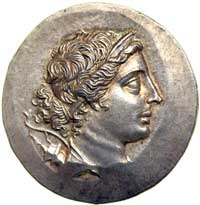 |
Ionia. Magnesia ad Maeandrum. Silver Tetradrachm (16.91g) struck ca. 160-150 BC. Herognetos son of Zopyrion, magistrate. Diademed and draped bust of Artemis right, bow and quiver over shoulder. Reverse: Apollo Delphios standing left, resting elbow on tripod, maeander pattern below; all within a laurel wreath. SNG Lockett 2829, Pozzi 2463. Bold and vivid Artemis. Splendid detail highlighted with russet hues. Superb Extremely Fine.
Estimated Value $2,000 - 2,500.
Wolfen Family Foundation, purchased from Bank Leu early 1970s.
View details and enlarged photos
| Realized
$2,070 |
Lot 4078 |
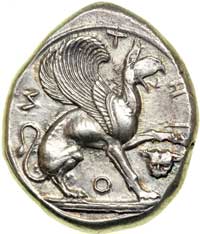 |
Ionia, Teos. Silver Stater (11.8g) struck ca. 470-449 BC. T - HI - O - N (N retrograde). Griffin seated right on "leaf and tongue" exergual line, wings raised, left forepaw lifted over panther head. Reverse: Quadripartite incuse square. Balcer, SNR 47, 103 (A.103/P.135); BMC 19 var. Delicately toned, unusually well centered and boldly struck. Superb Extremely Fine.
Estimated Value $4,000 - 5,000.
The Hunter Collection.
View details and enlarged photos
| Realized
$2,415 |
Lot 4079 |
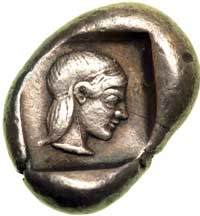 |
Caria, Knidos. Silver Drachm (6.44g) ca. 490-465 BC. Forepart of roaring lion right. Reverse: Head of Aphrodite right within incuse square. Cahn 66 (V30/R47); SNG Cop 224. Nicely toned. Evocative and humanistic depiction of Aphrodite. Oblongish flan. Nearly Extremely Fine.
Estimated Value $1,000 - 1,400.
Wolfen Family Foundation, purchased from Bank Leu early 1970s.
View details and enlarged photos
| Realized
$1,438 |
Lot 4080 |
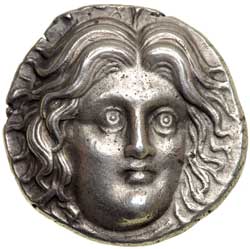 |
Islands off Caria, Rhodes. Silver Tetradrachm (13.29g). Struck 229-205 BC. Aemeinias, magistrate. Radiate head of Helios facing slightly right. Reverse: POΔIΩ] N. Rose with bud to right; prow to left, AMEINI-AΣ flanking stem. SNG Copenhagen 759; Ashton 212; SNG Keckman 542; BMC 134; SNG von Aulock 2799. Full nose, eyes and lips; all delicately toned. Exceptional strike in high relief from the finest dies of this period. Extremely Fine.
Estimated Value $5,000 - 6,000.
Ex Triton X (2007) lot 363.
View details and enlarged photos
| Realized
$6,900 |
Lot 4081 |
 |
Pamphylia, Aspendus / Aspendos, Silver Stater (10.87g) Struck ca. 370 BC. Two wrestlers grappling. Reverse: Slinger standing right; triskeles before, all within beaded square. SNG France 54; SNG v. Aulock 4543; SNG Cop 196. Oblong flan. The portraits on the slinger and wrestlers are simply superb. Beautiful, soft iridescent hues. Extremely Fine.
Estimated Value $1,500 - 2,000.
Wolfen Family Foundation, purchased from Bank Leu early 1970s.
View details and enlarged photos
| Realized
$3,220 |
Lot 4082 |
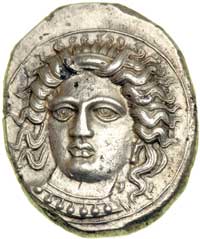 |
Cilicia, Tarsos. Silver Stater (10.5g) Struck 380-373 BC. Pharnabazos, Persian military commander. Head facing slightly left of female (Arethusa?) with streaming hair, wearing earring and wire choker over necklace of beads depending from strands; linear border. Reverse: Bearded male head left (Ares?) wearing crested Athenian helmet; ankh behind. SNG France 243; SNG Cop 267. Dark obverse deposit on forehead curl. Light antique gray toning. Extremely Fine.
Estimated Value $2,000 - 2,500.
The Hunter Collection.
View details and enlarged photos
| Realized
$2,300 |
Lot 4083 |
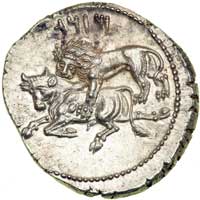 |
Cilicia, Tarsos. Silver Stater (10.9g) struck 361-334 BC. Mazaios, Satrap. Baaltars seated three-quarters left, head facing, holding eagle, grain-ear, grapes and scepter. Reverse: Lion left attacking bull. SNG France 335; SNG Levante Supp. 20. Lovely details with light mottled toning. Lustrous. Nearly Mint State.
Estimated Value $1,000 - 1,300.
The Hunter Collection.
View details and enlarged photos
| Realized
$1,610 |
Lot 4084 |
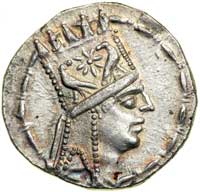 |
Armenian Kingdom. Tigranes II, 95-56 BC. Silver Tetradrachm (16.1g) minted at Antioch. Bust of Tigranes right wearing an Armenian tiara with five pyramidal points and adorned with a comet star between two eagles. Reverse: Antiochene Tyche seated right on rocks, holding a palm frond; river-god Orontes swimming right, below; TP monogram before; all within a laurel wreath. Nercessian (SCADA) Group 5 (A48/P13); Bedoukian (CAA) 40. Trivial earthen deposits. Soft gray tone with champagne highlights. A spectacular example, well struck on a large flan. Superb Extremely Fine.
After decades of fratricidal strife between various members of the Seleukid dynasty, the Syrians rose up against their rulers and invited Tigranes II, the Great, of Armenia to restore order in their kingdom (83 BC). His rule extended over the following fourteen years until he was eventually driven out of Syria by the Roman general Lucullus.
This superbly preserved tetradrachm issued at the Syrian capital of Antioch shows the king wearing his distinctive Armenian tiara on the obverse, while the reverse shows the city goddess, or Tyche, of Antioch with the river god Orontes swimming at her feet. This statue was created by the Greek sculptor Eutychides of Sikyon (ca. 335-275 BC) and its image appears on the reverses of many Antiochene coins down to early Byzantine times.
Estimated Value $5,000 - 7,500.
The Hunter Collection.
View details and enlarged photos
| Unsold |
Lot 4085 |
 |
Seleukid Kingdom. Seleukos I, Nikator, as satrap, 312-280 BC. Gold Stater (8.57g). Minted at Arados, ca. 311-300. In the name and type of Alexander the Great. Athena head right wearing crested Attic helmet adorned with griffin. Reverse: Nike (Victory) standing left, holding a wreath in her outstretched right hand and stylis in her left; anchor inner left; letter Π below; ΩΠ monogram lower right. Price 3352; SNG Lockett 1432. Minute earthen hues. Pleasing style. Choice Very Fine.
Estimated Value $3,000 - 4,000.
Wolfen Family Foundation, purchased from Bank Leu early 1970s.
View details and enlarged photos
| Realized
$4,255 |
Lot 4086 |
 |
Seleukid Kingdom. Seleukos I, Nikator, as satrap, 312-280 BC. Gold Stater (8.57g). Minted at Babylon ca. 311-300. In the name and type of Alexander III of Macedon. Helmeted head of Athena right, hair flowing in curls, griffin on helmet. Reverse: Nike (Victory) standing left, holding wreath and stylis; H in left field; MP monogram below left wing. Price 3707 var. (placement of H and monogram differ.); Müller 712; Seleucid Coins 81.7 (placement of H and monogram differ). A lovely lustrous example with some die rust noted on the reverse. NGC graded Mint State; Strike: 5/5, Surface: 5/5.
Estimated Value $4,000 - 5,000.
View details and enlarged photos
| Realized
$6,325 |
Lot 4087 |
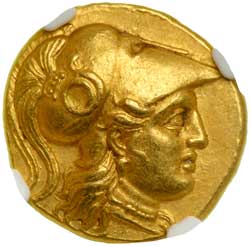 |
Seleukid Kingdom. Seleukos I, Nikator, as satrap, 312-280 BC. Gold Stater (8.55g). Minted at Babylon, ca. 311-300. In the name and type of Alexander III of Macedon. Helmeted head of Athena right, serpent on helmet. Reverse: Nike (Victory) standing left, holding wreath and stylis over shoulder; MI in left field; MP monogram below in right field. Price 3748; Müller 731; Seleucid Coins 81.2. Struck in high relief. NGC graded Choice AU*; Strike: 5/5, Surface: 5/5 Fine Style.
Estimated Value $3,000 - 4,000.
View details and enlarged photos
| Realized
$3,910 |
Lot 4088 |
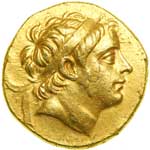 |
Seleukid Kingdom. Seleukos III, Keraunos, 226-223 BC. Gold Oktadrachm (34.15g) minted at Antioch, ca. 226. Diademed head right of Seleukos III. Reverse: [B]AΣIΛEΩΣ [Σ]EΛE - YKOY. Apollo seated left on omphalos, examining arrow in his right hand, resting left on grounded bow; to left and right, monograms. Cox, ANSMN XII, pl. XXI, 4; cf. WSM 1029ρ-φ (silver tetradrachms from same obverse die); Seleucid Coins, pl. 45.920; Antioche de Syrie 4 and 80, dies A1-P3 and A5-P55. A few surface scuffs on the obverse. Extremely Fine.
One of two known, the second example in the Archaeological Museum, Ankara. Each from Gordian Hoard VII, and each struck from tetradrachm dies. A coin of great numismatic importance.
Newell hypothesized that this issue was struck to finance preparations for the planned reconquest of the Seleukid provinces in Asia Minor that had been lost by Antiochos, Hierax to Attalos I of Pergamon. In view of the exceptional character of gold at this period, it may not be farfetched to regard this remarkable oktadrachm as created as an accession donative.
Unlike the Ptolemaic Egyptian series, all large Seleukid gold is very rare, and specimens are seldom offered for sale. This handsome oktadrachm, struck from tetradrachm dies, was issued at Antioch under Seleukos III, Keraunos (the Thunderbolt), the elder son of Seleukos II and Laodike II. He came to the throne in his late teens on the death of his father in a hunting accident in 226 BC. Seleukos III inherited a chaotic situation in which the Seleukid kingdom seemed headed for disintegration. Whether he would have been equal to the task of reestablishing the regal authority we shall never know, as he fell victim to two of his own officers after a reign of only three years. Fortunately, his younger brother Antiochos (later Antiochos III, the Great) was able to take possession of his inheritance and to restore the fortunes of the kingdom. On his coinage, Seleukos III reverted to the traditional dynastic reverse of Apollo seated on the omphalos, the navel stone of the earth. His father, Seleukos II, had introduced an elegant standing figure of the god resting on a tall tripod but his sons abandoned this innovative design.
Estimated Value $50,000 - 60,000.
The Hunter Collection; Ex Numismatic Fine Arts XXV, November 29, 1990, lot 209.
View details and enlarged photos
| Realized
$207,000 |
Lot 4089 |
 |
Phoenicia, Sidon. Ba`lshallim I, ca. 420-410 BC. Silver Double Shekel (27.18g). Galley left, with row of shields along bulwark, before embattled city wall with five crenellated towers; in exergue, two lions facing outward. Reverse: King of Persia and driver in chariot left, drawn by three galloping horses; below, incuse goat running left, head reverted; around, double border of dots; all within circular incuse. Betlyon, ANSMN 21, 6.
Exceedingly rare and probably the finest known specimen. Nearly Extremely Fine.
The majestic defensive walls of the great maritime city of Sidon are viewed here as they would have appeared in the late fifth century BC. Probably the oldest of the Phoenician cities and reputedly the mother city of Tyre, Sidon became subject to the overlordship of the Persian kings in the second half of the sixth century. Its celebrated fleet provided the principal naval contingent for Xerxes when he invaded Greece in 480 BC. Kraay suggested that the obverse scene could depict the commissioning of a new galley by the king before the walls of the city, while the heraldically disposed lions below are symbolic of the king's enemies. The reverse shows the King of Persia being driven at high speed in a three-horse chariot.
Estimated Value $10,000 - 15,000.
The Hunter Collection; Acquired in the early 1980s for the Hunter Collection, but the pedigree ticket has been lost, thus worthy of more research.
View details and enlarged photos
| Realized
$26,450 |
Lot 4090 |
 |
Judaea. The Jewish War, 66-70 CE. Silver Shekel (14.1g) dated Year Three (68/69 CE). "Year 3" in paleo-Hebrew above Omer cup; "Shekel of Israel" in paleo-Hebrew, around. Reverse: "Jerusalem the Holy" in paleo-Hebrew. Sprig of three pomegranates. Meshorer 202; Hendin 1361. Excellent metal and lustrous. Nearly Mint State.
Estimated Value $4,000 - 5,000.
View details and enlarged photos
| Realized
$9,200 |
Lot 4091 |
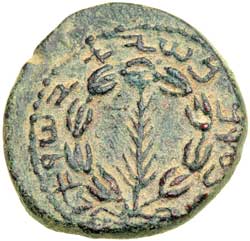 |
Judaea. Bar Kochba Revolt, 132-135 CE. Middle Bronze AE 24, dated Year One (132/3 CE). "Simon, Prince of Israel" in paleo-Hebrew. Palm branch within wreath; dotted border. Reverse: "Year One of the redemption of Israel" in paleo-Hebrew. Wide lyre with six strings; dotted border. Hendin 1377; Mild. 23; TJC 223a; GBC 1377. Pleasing green patina. A splendid specimen and very rare this choice. Superb Extremely Fine.
Estimated Value $1,500 - 2,000.
View details and enlarged photos
| Realized
$3,220 |
Lot 4092 |
 |
Philistia (Palestine), Gaza. Silver Tetradrachm (16.95g) struck 4th Century BC. Helmeted head of Athena right, wearing earring. Reverse: AΘE. Eagle with closed wings, standing right; in upper left field, olive twigs with berry and crescent before; mem in Aramaic characters. Mildenberg, Studies Price pl. 61, 67-68; Gitler-Tal pl. XXIV, V.17b. Extremely Rare. Toned. The most spectacular Gaza mint tetradrachm we have seen. Extremely Fine.
Estimated Value $15,000 - 20,000.
Ex Numismatica Ars Classica 52, lot 186.
View details and enlarged photos
| Realized
$24,150 |
Lot 4093 |
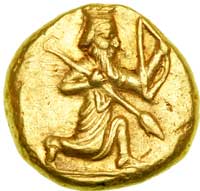 |
Persia, Achaemenid Empire. Darius I to Xerxes II, ca. 485-420 BC. Gold Daric (8.4 g). Persian king / hero in a kneeling / running stance right, holding a spear and bow; quiver over shoulder. Reverse: Incuse punch. Carradice type III b A/B; BMC Arabia pl. XXIV, 26. An excellent, well-centered and sharp example of this often idiosyncratic early type. Extremely Fine.
Estimated Value $2,500 - 3,000.
The Hunter Collection.
View details and enlarged photos
| Realized
$8,913 |
Lot 4094 |
 |
Persia, Achaemenid Empire. Time of Xerxes II to Artaxerxes II, 420-375 BC. Gold Daric (8.4g). Persian king / hero right in running / kneeling stance, holding tranverse spear and bow. Reverse: Incuse punch. Carradice type IV; SNG Copenhagen 277. Reddish earthen hues on reverse. Extremely Fine.
The coin above is a perfect example of the transitioning of the depiction of the hero / king from the earlier type of 485-420 BC, which shows a coarse, crude figure in Eastern style to a finer style where the hero / king's profile is more Hellenistic.
Estimated Value $3,000 - 4,000.
The Hunter Collection.
View details and enlarged photos
| Realized
$2,128 |
Lot 4095 |
 |
Persia, Achaemenid Empire. Xerxes II to Artaxerxes II, ca. 420-375 BC. Gold Daric (8.30g) probably minted at Sardeis. Persian king / hero in a kneeling / running stance right, holding a spear and bow; quiver over shoulder. Reverse: Incuse punch. Carradice type Iiib C; BMC Arabia pl. XXV, 12. Fine style. Extremely Fine.
Estimated Value $2,500 - 3,000.
The Hunter Collection.
View details and enlarged photos
| Realized
$4,600 |
Lot 4096 |
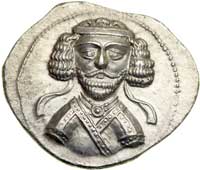 |
Parthian Kingdom. Phraates III, ca. 70-57 BC. Silver Drachm (4.1g). Minted at Mithradatkart, ca 62 BC. Diademed facing bust, wearing necklace with medallion. Reverse: Archer (Arsakes I) seated right on throne holding bow. Sunrise 328; Sellwood 35.4 (Darius?) Shore-. A marvelous specimen, lightly toned, struck in high relief on a large flan and needle sharp. The finest example of this rare issue we have seen. Nearly Mint State.
Estimated Value $3,000 - 4,000.
View details and enlarged photos
| Realized
$5,290 |
Lot 4097 |
 |
Parthian Kingdom. Phraatakes with Musa, 2 BC - AD 4. Silver Drachm (3.8g) minted at Ekbatana. Diademed bust of Phraatakes left, no wart on forehead; opposed Nike (Victory) figures flanking, each crowning Phraatakes with a wreath. Reverse: Diademed and crowned bust of Musa left. Sunrise 404; Sellwood 58.9; Shore 324. Well centered on a large flan. Very rare in such high grade. Extremely Fine.
Estimated Value $3,500 - 4,000.
View details and enlarged photos
| Realized
$5,290 |
Lot 4098 |
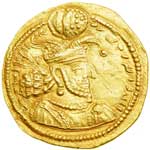 |
Sasanian Kingdom. Ohrmazd (Hormizd) II, AD 303-309. Gold Dinar (7.25g). Bust right, in eagle crown with korymbos; ethnic legend. Reverse: Fire altar with ribbon and bust left in flames; attendants to either side, the left wearing winged crown, the right wearing mural crown, both with korymbos; to left and right, ethnic legends. SNS type Ia/3d; Göbl type I/1a (pl. 5, 81). Very rare. Choice Very Fine.
Estimated Value $4,000 - 5,000.
The Hunter Collection; Ex Superior Stamp & Coin, December 6-7, 1996, lot 1615A.
View details and enlarged photos
| Realized
$3,910 |
Lot 4099 |
|
Withdrawn
| Unsold |
|
|